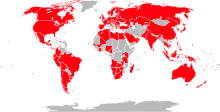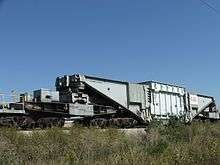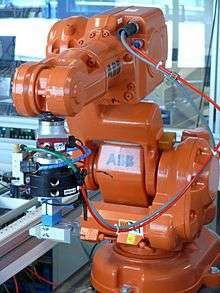ABB Group
 | |
| Publicly traded limited company | |
| Traded as |
SIX: ABBN NYSE: ABB Nasdaq Stockholm: ABB |
| Industry | Electrical equipment |
| Founded | 1988 through merger of ASEA (1883) of Sweden and Brown, Boveri & Cie (1891) of Switzerland |
| Headquarters | Zurich, Switzerland |
Area served | Worldwide |
Key people | Ulrich Spiesshofer (CEO), Peter Voser (Chairman) |
| Products | Power, Automation |
| Revenue |
|
|
| |
|
| |
| Total assets |
|
| Total equity |
|
Number of employees | 147,000[3] |
| Website |
www |
ABB (ASEA Brown Boveri) is a Swedish-Swiss multinational corporation headquartered in Zurich, Switzerland, operating mainly in robotics, power, heavy electrical equipment and automation technology areas. It is ranked 341st in the Fortune 500 global list of 2018 and has been a global Fortune 500 company for 24 years.[4]
ABB is traded on the SIX Swiss Exchange in Zürich, Nasdaq Stockholm and the New York Stock Exchange in the United States.[5]
History
ABB's history goes back to the late 19th century. Allmänna Svenska Elektriska Aktiebolaget (General Swedish Electrical Limited Company, ASEA) was founded in 1883 by Ludvig Fredholm[6] in Västerås as manufacturer of electrical light and generators. Brown, Boveri & Cie (BBC) was formed in 1891 in Baden, Switzerland, by Charles Eugene Lancelot Brown and Walter Boveri[7] as a Swiss group of electrical companies producing AC and DC motors, generators, steam turbines and transformers.

ABB was created as the result of the merger of the Swedish corporation ASEA and the Swiss company Brown, Boveri & Cie (BBC) in 1988. The latter had acquired Maschinenfabrik Oerlikon in 1967. The former CEO of ASEA, Percy Barnevik ran the company until 1996.

In 1990, ABB purchased Westinghouse's metering and control division (the load control division was spun off to Cannon Technologies in the late 1990s and the meter division was spun off to Elster Electricity in the early 2000s). Also, in the early 1990s, ABB purchased Combustion Engineering (C-E), headquartered in Stamford and Norwalk, Connecticut, a leading U.S. firm in the development of conventional fossil fuel power and nuclear power supply systems to break into the North American market. Klaus Agthe was CEO of the US operation at the time. Continuing with its expansion plans, ABB purchased Elsag Bailey,[8] a process automation group, in 1997 which included Bailey Controls, Hartmann & Braun, and Fischer & Porter. This was the largest acquisition to date in ABB's history.
ABB bought International Combustion Ltd[9] from Rolls-Royce[10] in 1997.
Alstom acquired ABB's boiler and fossil fuel operations in 2000 while its nuclear business was purchased by Westinghouse Electric Company in 2000. In 2000, ABB also signed a contract for the delivery of equipment and services for two North Korean nuclear powerplants to be supplied under an agreement with the Korean Peninsula Energy Development Organization (KEDO),[11] a consortium formed in 1995 by the governments of the United States, Japan, South Korea and the European Union.[12] ABB formally divested from a joint venture named ABB-Alstom Power in 2000, and sold its interest in conventional power generation systems to Alstom Power. ABB's nuclear business was sold[13] to BNFL and merged into Westinghouse Electric Company.
In 2001, ABB was ranked as number one on the Dow Jones corporate sustainability index[14] for the third year in a row.
In 2002, ABB asked Lindahl, the company's former chief executive, to return some of his $50 million retirement pay, which its board called excessive. ABB also asked its former chairman Percy Barnevik to pay back part of his $87 million pension package. The size of the pensions was disclosed at the same time as ABB's $691 million net loss for 2001 made headlines and drew sharp criticism in Switzerland and Sweden.[15]
ABB's Building Systems business unit was sold off in 2004 to Capvis,[16] a Swiss private equity company, as part of ABB's strategy to focus on power and automation technologies. ABB's building systems businesses in Australia and Hong Kong were sold off the year before, in May 2003, to Downer EDI Limited. Building Systems provided services for building facilities encompassing indoor air quality, building automation as well as power distribution and management.
Financial debt and lingering asbestos liability brought ABB to the brink of bankruptcy in the early 2000s. In 2006, ABB recovered financially by settling asbestos issues brought by its U.S. subsidiaries, Combustion Engineering and Lummus Global.[17] In August 2007 Lummus Global was sold to CB&I.[18]
In December 2008, ABB acquired Ber-Mac Electrical and Instrumentation to expand its presence in western Canada's oil and gas industries.
In 2009, ABB realigned its automation divisions . As of January 1, 2010, the business units in the Automation Products and Robotics divisions were regrouped into two new divisions – Discrete Automation and Motion, and Low Voltage Products. The Process Automation division remained unchanged except for the addition of the instrumentation business from the Automation Products division.
In May 2010, ABB acquired software company Ventyx for more than $1 billion from Vista Equity Partners.[19] In 2011, on May 9 ABB announced acquisition of Australian-based Mincom Limited from private equity firm Francisco Partners for an undisclosed sum.[20] On July 29, 2011, acquisition has been finalised.[21] Mincom and Ventyx were subsequently integrated under the Ventyx name, and have now been integrated into ABB as the Enterprise Software Product Group.
In 2011 ABB acquired Baldor Electric USA for $4.2 billion in an all-cash transaction On January 30, 2012, ABB Group acquired Thomas & Betts in a $3.9 billion cash transaction.[22] On June 15, 2012, it completed acquisition of commercial and industrial wireless technology specialists Tropos. In July 2013, ABB acquired Power-One in a $1 billion all-cash transaction, to become the leading global manufacturer of solar inverters . On June 30, 2018, ABB completed its acquisition of GE Industrial Solutions, GE's global electrification business. The transaction was announced on September 25, 2017.[23]
Organizational structure
ABB is the world's largest builder of electricity grids[24] and is active in many sectors, its core businesses being in power and automation technologies. With a long history of growth through mergers and acquisitions, it entered a phase of structure unification since 2014. The company has one corporate division and four production divisions. reorganization in January 2017. ABB implements the matrix structure .
Electrification Products
The Electrification Products division manufactures low- and medium-voltage electrical products, including electric vehicle infrastructure, solar inverters, modular substations, distribution automation; products to protect people, installations and electronic equipment from electrical overload such as enclosures, cable systems and low-voltage circuit breakers; measuring and sensing devices, control products, switches and wiring accessories. The division further makes KNX systems that integrate and automate a building's electrical installations, ventilation systems, and security and data communication networks. Electrification Products also incorporates an Electrification Solutions unit manufacturing low voltage switchgear and motor control centres. Customers include a wide range of industry and utility operations, plus commercial and residential buildings.
The acquisition of GE Industrial Solutions, which closed in June 2018, further strengthened ABB's #2 global position in electrification.[23]
Robotics and Motion

The Robotics and Motion division provides products and services for industrial production. It includes electric motors, generators, drives, power electronics and industrial robots. ABB has installed over 300,000 robots.[25] In 2006, ABB opened a manufacturing centre in Shanghai, China. Also, wind generators, solar power inverters and UPS products belong to this division.
Industrial Automation[26]
The Industrial Automation division provides systems for control, plant optimization, and industry-specific automation applications. The industries served include oil and gas, power, chemicals and pharmaceuticals, pulp and paper, metals and minerals, marine and turbocharging. The division consists of seven business units: Control Technologies (the world's No 1 DCS supplier); Marine & Ports; Measurement & Analytics; Oil, Gas & Chemicals; Power Generation & Water; Process Industries and Turbocharging.
Power Grids
The Power Grids division offers components for the transmission and distribution of electricity. The division incorporates ABB's manufacturing network for transformers, switchgear, circuit breakers, and associated high voltage equipment such as digital protective relays. It also offers maintenance services. The division also offers turnkey systems and service for power transmission and distribution grids and for power plants; this includes electrical substations and substation automation systems flexible AC transmission systems (FACTS), high-voltage direct current (HVDC) systems, and network management systems. The division is subdivided into the four business units High Voltage Products, Transformers, Grid Automation and Grid Integration.
Other
In May 2013, ABB Sécheron SA joined with several groups in Geneva TOSA (Trolleybus Optimisation Système Alimentation, or in English, Trolleybus Power System Optimization) in a one-year demonstration of a trolleybus route using a novel charging system. Rather than overhead wires, charging is accomplished by fixed overhead devices located at stops along the route and at the terminus.[27][28][29] Jean-Luc Favre, head of Rail ISI, discussed the promising role of improved electric transport technology in ABB.[30]
Implementation of IT
ABB group saw the market change due to the entrance of the IT industry and partnered up with IBM. IBM is a large player within the technology industry.[31] This helped ABB group in managing the transition into implementing the technology in their core business.
Management
Ulrich Spiesshofer has been the chief executive officer since September 2013. The board of directors[32] is chaired by Peter Voser. He was elected in April 2015 and succeeded Hubertus von Grünberg, who had been Chairman since May 2007. Jürgen Dormann was chairman from 2002 to 2007, and Percy Barnevik from 1999 to 2002.
Primary investors
The largest single stake in the firm is held by the Swedish investment company Investor AB, controlled by the Wallenberg family, which holds 10.48%.[33]
See also
References
- 1 2 3 "Facts and figures". new.abb.com. Retrieved 2018-02-20.
- 1 2 "ABB Annual Report 2017" (PDF). ABB.com. ABB. Retrieved 30 July 2018.
- ↑ "ABB Q2 2018 results". ABB.com. ABB. Retrieved 30 July 2018.
- ↑ "Fortune 500 - ABB". Fortune.com. Retrieved 8 August 2018.
- ↑ "Share - Listing information". new.abb.com.
- ↑ "Ludvig Fredholm".
- ↑ "Walter Boveri".
- ↑ "Elsag Bailey was acquired by ABB Group". 1999, Elsag Bailey Process Automation N.V. was acquired by ABB Group. www.bloomberg.com.
- ↑ "International Combustion Ltd from American roots to Sinfin Lane". Bygonederbyshire.co.uk. 2010-12-06. Retrieved 2010-12-12.
- ↑ "UK Business Park". UK Business Park. Archived from the original on 25 January 2012. Retrieved 2010-12-12.
- ↑ "Press release: ABB to deliver systems, equipment to North Korean nuclear plants". ABB. 20 January 2000. Retrieved 2009-09-13.
- ↑ Randeep Ramesh (2003-05-09). "The two faces of Rumsfeld". London: The Guardian.
- ↑ "Press release: ABB to sell nuclear business to BNFL". ABB. 29 December 1999. Retrieved 2009-09-13.
- ↑ "Dow Jones Sustainability Indexes". Archived from the original on 27 April 2007.
- ↑ Edith M. Lederer (2002-03-01). "UN: Swedish Businessman Loses Job". CorpWatch. Retrieved 2010-12-12.
- ↑ "ABB sells Swiss Building Systems business". Abb.com. 2004-02-20. Retrieved 2010-12-12.
- ↑ Uncredited (September 1, 2006). "ABB asbestos claims resolved". Reuters.
- ↑ Krauskopf, Lewis (2007-08-27). "CB&I to buy Lummus Global from ABB". Reuters.com. Retrieved 2010-12-12.
- ↑ "ABB acquires Ventyx to strengthen its network management business". abb.com. 2010-05-05. Retrieved 2012-08-27.
- ↑ "ABB Press Release: ABB acquires Mincom to expand enterprise software business" (PDF). abb.com. 2011-05-09. Retrieved 2011-08-06.
- ↑ "ABB Press Release: ABB completes acquisition of Mincom" (PDF). abb.com. 2011-07-29. Retrieved 2011-08-06.
- ↑ "Thomas & Betts Corporation Reports Fourth Quarter 2011 Net Earnings" (PDF). www.tnb.com. 2012-01-30. Retrieved 2012-02-01.
- 1 2 "ABB completes acquisition of GE Industrial Solutions". Retrieved 2018-07-30.
- ↑ Anjili Raval (18 February 2010). "ABB's acquisitive mood leads to big gains". Financial_Times.
- ↑ "ABB Robotics". ABB. 2016. Retrieved 23 September 2016.
- ↑ Lunner-Kolstrup, Christina; Hörndahl, Torsten; Karttunen, Janne P. (2018-07-03). "Farm operators' experiences of advanced technology and automation in Swedish agriculture: a pilot study". Journal of Agromedicine. 23 (3): 215–226. doi:10.1080/1059924x.2018.1458670. ISSN 1059-924X.
- ↑ Mike Millikin, ed. (31 May 2013). "ABB develops and demonstrates "flash charging" system for electric buses". Green Car Congress. Retrieved 2012-06-01.
- ↑ Zachary Shahan (31 May 2013). "ABB Unveils Ultrafast, 15-Second "Flash Charging" Electric Bus". CleanTechnica. Retrieved 2013-06-01.
- ↑ "New Charging Technology from ABB - Analyst Blog". Zachs Investment Research. 31 May 2013. Archived from the original on 9 February 2015. Retrieved 2013-06-01.
- ↑ "Geneva Unveils Electric Bus without Overhead Wires (see video of interview)". The Local, Switzerland's News in English. 21 April 2013. Retrieved 2013-06-01.
- ↑ Shomalia, Azadeh; Pinkseb, Jonatan (20 January 2016). "The consequences of smart grids for the business model of electricity firms". Journal of Cleaner Production. 112 (5): 3830–3841. doi:10.1016/j.jclepro.2015.07.078.
- ↑ "ABB Board of Directors". Abb.com. Retrieved 2015-10-25.
- ↑ "ABB: Major shareholders".
Further reading
- ABB (2005): The Dormann Letters, Jürgen Dormann/ABB Group, Zurich
- Bélanger, Jacques et al. (2001): Being local worldwide: ABB and the challenge of global management, Cornell University Press, New York. ISBN 0-8014-3650-8
- Kevin Barham, Claudia Heimer (1998): ABB: the dancing giant – creating the globally connected corporation. Financial Times, London. ISBN 0-273-62861-5
External links
| Wikimedia Commons has media related to ABB Group. |